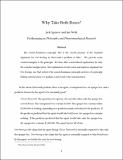| dc.contributor.author | Spencer, Jack | |
| dc.contributor.author | Wells, Ian Thomas | |
| dc.date.accessioned | 2018-05-14T14:31:39Z | |
| dc.date.available | 2018-05-14T14:31:39Z | |
| dc.date.issued | 2017-10 | |
| dc.identifier.issn | 00318205 | |
| dc.identifier.uri | http://hdl.handle.net/1721.1/115358 | |
| dc.description.abstract | The crucial premise of the standard argument for two‐boxing in Newcomb's problem, a causal dominance principle, is false. We present some counterexamples. We then offer a metaethical explanation for why the counterexamples arise. Our explanation reveals a new and superior argument for two‐boxing, one that eschews the causal dominance principle in favor of a principle linking rational choice to guidance and actual value maximization. | en_US |
| dc.publisher | Wiley-Blackwell | en_US |
| dc.relation.isversionof | http://dx.doi.org/10.1111/PHPR.12466 | en_US |
| dc.rights | Creative Commons Attribution-Noncommercial-Share Alike | en_US |
| dc.rights.uri | http://creativecommons.org/licenses/by-nc-sa/4.0/ | en_US |
| dc.source | MIT Web Domain | en_US |
| dc.title | Why Take Both Boxes? | en_US |
| dc.type | Article | en_US |
| dc.identifier.citation | Spencer, Jack and Ian Wells. “Why Take Both Boxes?” Philosophy and Phenomenological Research (October 2017) © 2017 Philosophy and Phenomenological Research, LLC | en_US |
| dc.contributor.department | Massachusetts Institute of Technology. Department of Linguistics and Philosophy | en_US |
| dc.contributor.mitauthor | Wells, Ian Thomas | |
| dc.relation.journal | Philosophy and Phenomenological Research | en_US |
| dc.eprint.version | Author's final manuscript | en_US |
| dc.type.uri | http://purl.org/eprint/type/JournalArticle | en_US |
| eprint.status | http://purl.org/eprint/status/PeerReviewed | en_US |
| dc.date.updated | 2018-05-14T13:35:08Z | |
| dspace.orderedauthors | Spencer, Jack; Wells, Ian | en_US |
| dspace.embargo.terms | N | en_US |
| dc.identifier.orcid | https://orcid.org/0000-0002-1698-8346 | |
| mit.license | OPEN_ACCESS_POLICY | en_US |
